Sauerkraut for the winter - cooking a delicious and crispy billet
Foreword
Sauerkraut for the winter is one of the most delicious, healthy and popular pickles. It is loved as a separate dish and without it it is impossible to cook some of the others (vinaigrette, cabbage soup, etc.) truly tasty. Sauerkraut is healthier than fresh - it not only retains all the vitamins and microelements present in the vegetable cut from the garden, it also adds active healing substances formed during the fermentation of the product.
Of course, you can ferment absolutely any cabbage. However, to prepare a truly delicious dish, you should be guided by some recommendations for choosing this vegetable. First of all, it should be noted that the best. Moreover, not every variety is suitable, and when buying or choosing a head of cabbage cut from the garden, you need to pay attention to its appearance.
Medium-late, and preferably late varieties of white cabbage should be used. The early ones are worse because their heads are loose and with a much lower sugar content, which is necessary not only for the good taste of the workpiece, but also for fermentation during fermentation. Therefore, the best period for sourdough cabbage is mid-late autumn, when the forks of late varieties of this vegetable ripen and acquire the desired density.
Only really well-ripened forks should be chosen - they will contain enough sugar. It is best to take larger heads, slightly flattened and almost pure white. Their impressive size will indicate sufficient maturation. However, the head of cabbage should not be too large either. Firstly, it will not be very convenient to cut it, and secondly, it is possible that such a vegetable was “fed” with fertilizers that accelerated its growth.
When choosing forks, you need to pay attention to the upper outer leaves covering them. They should be light green in color. If almost white, then, most likely, the heads of cabbage were frozen, and the seller, wanting to hide this, removed the top leaves.
The stalk should be without damage and signs of rot, dense and white. There should be no inclusions, spots or holes on the leaves. The smell of the head should be vegetable and fresh. If it smells of rot, you need to choose another fork.
The choice of dishes for pickling
The best utensils for pickling any vegetables are wooden. Previously used oak barrels or tubs. If cabbage is fermented in such a container, then it will additionally acquire a pleasant aroma and flavor.
A worthy replacement for oak dishes is enameled. An important condition for its use is that the enamel on the entire inner surface of the container should not have any chips or cracks. You can use enameled jars, pots and even buckets. Clay containers are also suitable.
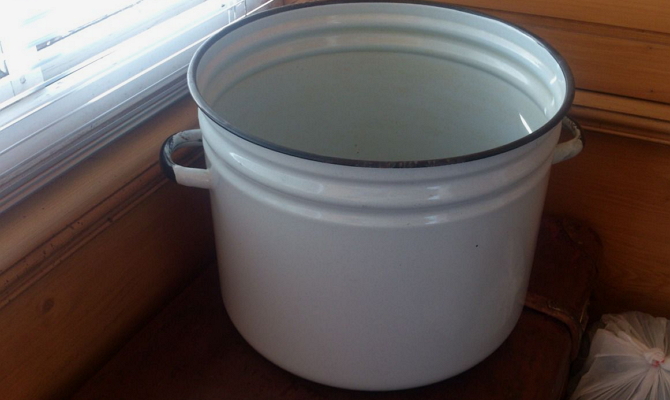
If there is a basement or cellar, you must definitely take dishes of impressive size. Only in a large volume can ferment cabbage really well.
Steel, aluminum and plastic containers are not suitable at all.
The lactic acid released during sauerkraut and the brine itself will react with metal or plastic. Because of this, the workpiece will have an unpleasant aftertaste, and the formation of harmful and even dangerous substances may also occur.
When there is no basement or cellar and you have to ferment cabbage in the apartment, it is best to use glass jars. Their volume must be at least 3 liters.
Ingredients and their ratio
The main ones are cabbage, carrots and salt. We take as much cabbage as we are going to pickle. Carrots - at your own discretion. It gives sauerkraut a sweetish pleasant aftertaste and makes it more fragrant, juicy and crispy, and the appearance of the dish served on the table is more attractive. In the classic recipe for carrots, 1 kg is taken per 10 kg of cabbage, and this is enough. But more is possible, as is offered in various other cooking options. If you take too many carrots, they will overpower the taste of cabbage.
Salt is a separate issue. The main thing is that it should not exceed 25 g per 1 kg of vegetables. Otherwise, it will turn out not fermentation, but salting. The second requirement for salt is that it must be non-iodized. It is better to use coarse, but fine grinding is also possible. Iodized salt will make cabbage not very tasty, not as crispy and can become unpleasant to eat - slippery.
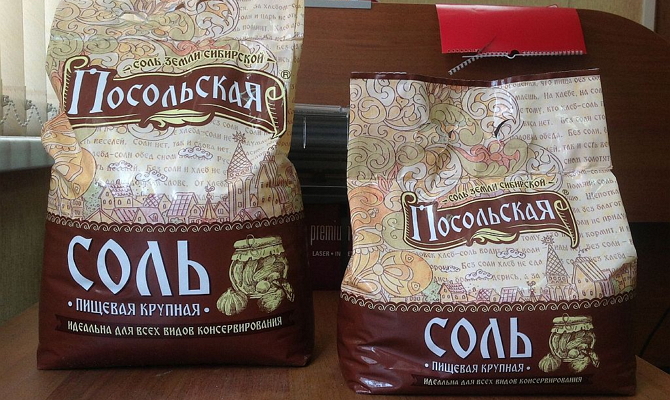
You can ferment cabbage with the addition of various spices and seasonings: dill seeds, bay leaves, black pepper, cloves, horseradish and others. They will give the workpiece a pleasant aroma and spicy aftertaste. However, you have to be careful when adding them. If overdone, the spices will overpower the natural taste of the cabbage.
Sugar is often added, especially if the cabbage is unripe or early varieties. They take it, as a rule, in the same proportions as salt - up to 25 g per 1 kg of vegetables. Firstly, sugar improves fermentation, and secondly, cabbage sauerkraut with it turns out to be more pleasant and delicate in taste, sometimes even sweetish, and also less acidic.
Some people ferment cabbage with fruits and/or berries, such as plums, apples, lingonberries, cranberries. These ingredients give the preparation a pleasant sour taste. You can add beets. The cabbage will acquire a ruby color and an unusual taste.
How to cut vegetables properly
You can ferment cabbage as a whole by dividing the head of cabbage in half or into several parts, cutting the leaves into large or small squares, triangles or rectangles, and also chopping it into narrow strips. Most often, the latter option is used. So the vegetable is fermented faster and more evenly. Moreover, it is necessary to chop quite finely, but it is also not worth grinding too much. Otherwise, the sliced \u200b\u200bpieces will soften during fermentation and the cabbage will turn into porridge, it will not be crispy.
You can cut with a sharp knife. Even better - a special shredder designed for chopping cabbage. With its help, this vegetable will be cut correctly and quickly.
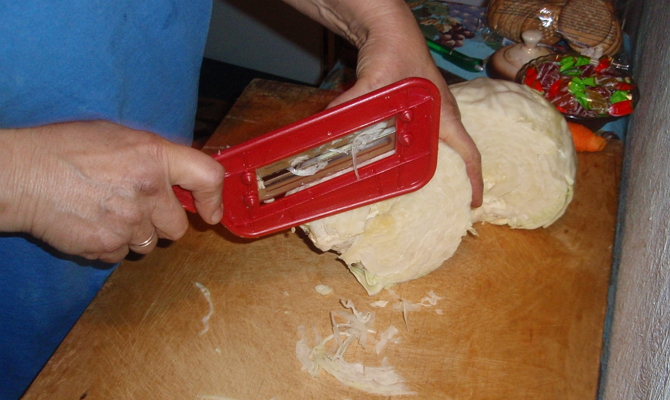
It is strongly not recommended to use a grater for chopping heads of cabbage. Pieces of leaves will turn out to be too small and crushed, they will no longer be crispy and juice will stand out from them ahead of time.
Carrots, regardless of the recipe, can be grated on a regular grater with large or medium cells. Often they use Korean-style carrots intended for cooking.
If according to the recipe it is necessary to add other products, then the berries are left whole, the plums too, or they are cut in half, but in any case, the seeds are removed. and beets are cut at their discretion: in half, into several parts or slices, plates. Small and small are best left whole.
Methods and temperature conditions of fermentation
There are two main methods, conditionally called wet and dry. In the first case, cabbage is mixed with carrots and spices when they are used, and then placed tightly in a pickling container or layered in it with other products (apples, berries or others), if they are in the recipe. Then everything is poured with boiled brine, cooled or hot. If sugar is added, then it is dissolved along with salt during boiling.
Taking the dry method as the basis for the recipe, first mix or even grind the cabbage with salt and knead a little so that it gives juice. Then mix with carrots. This is usually done in an enamel cup in portions. They take 1 proportional part of cabbage, salt and carrots, mix them and put them in a pickling container, tamping as shown in the video. Then do the same with the following portions. In parallel, layers are placed in a container and other products (apples, berries or others), if they should be. Cabbage is not poured with water or brine, but fermented in its own juice, which is released during fermentation.
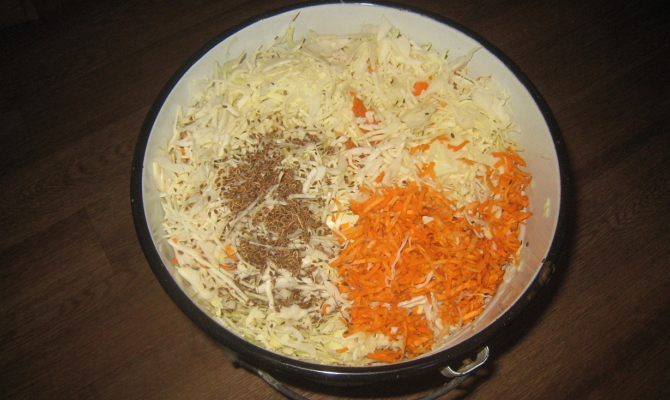
If the recipe calls for sugar or spices, they are added while mixing cabbage with carrots. Strongly knead and tamp vegetables is not worth it, otherwise the workpiece will not turn out crispy.
Regardless of the method and recipe for fermentation, the next thing to do is to cover the cabbage with clean gauze or cloth and press down with oppression (load). To do this, an enameled lid or plate of a suitable size is placed on it in a wide container, and a load is placed on top - a washed natural stone or a jar of water. Metal objects will not work. If the cabbage is fermented in a jar, then you can put nothing at all or use a small jar of water.
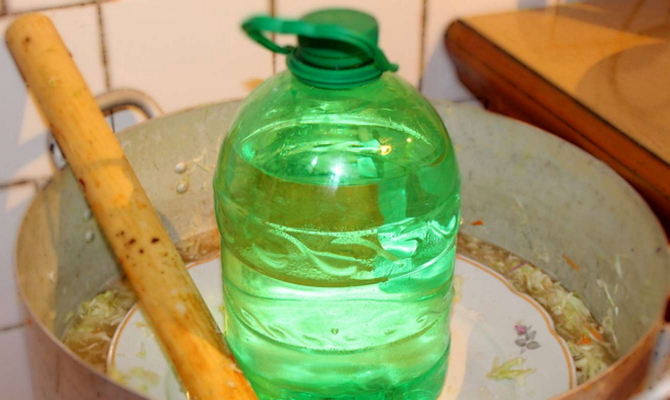
The first few days - usually three days, sometimes more - cabbage should ferment at room temperature. During this period, harvesting vegetables needs constant monitoring. The fermentation foam must be skimmed off regularly, and the cabbage must be pierced in several places with a clean wooden kitchen utensil to allow the escaping gases to escape. If all this is not done, then you can forget about a tasty, and even more so, crispy snack. The workpiece will turn out bitter and sour.
When the foam ceases to stand out, and the brine brightens, the cabbage can already be eaten, although it is still undercooked. The container with it should be placed in a dark, cool place. Better in the cellar, and in the absence of such, you can also in the refrigerator. To ferment completely, cabbage should stand there for about a month. And then it is stored there for up to 9 months. The optimum temperature for further fermentation and subsequent storage is 0–+2 o C.
